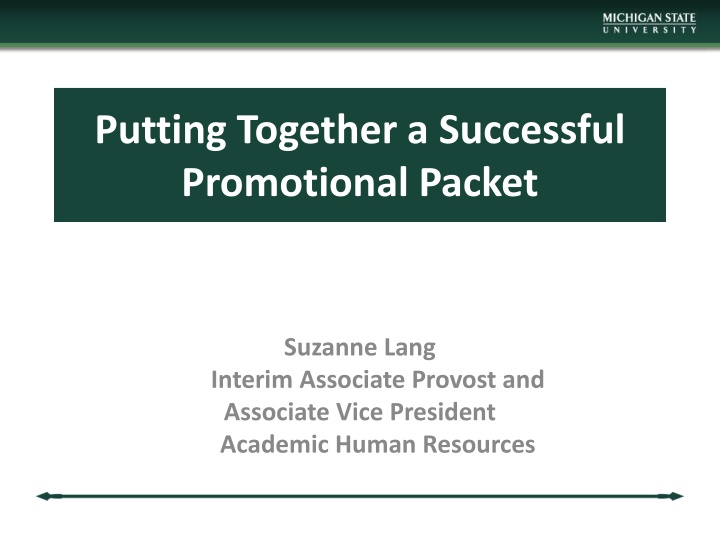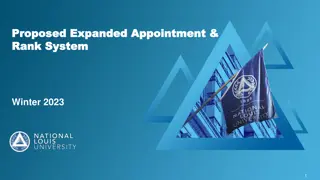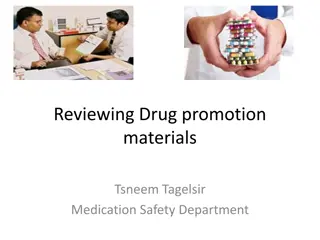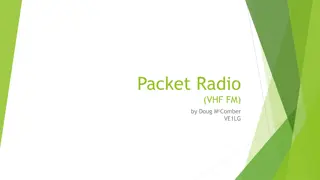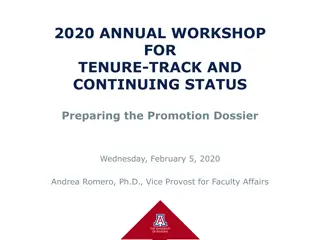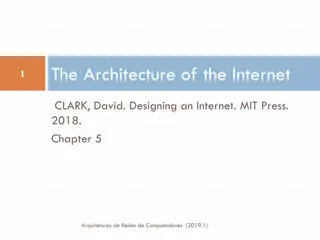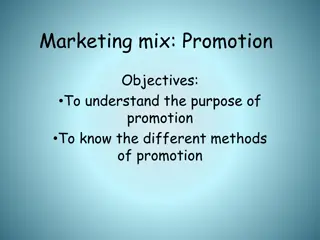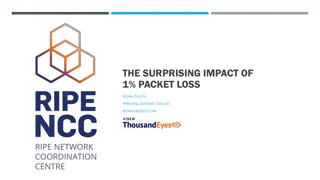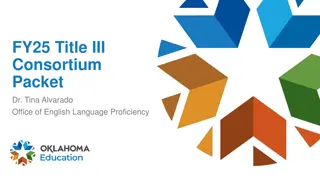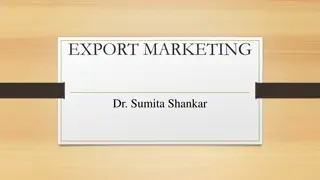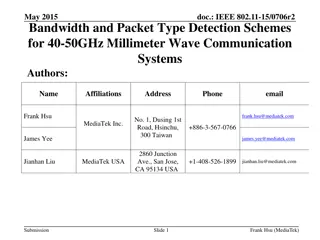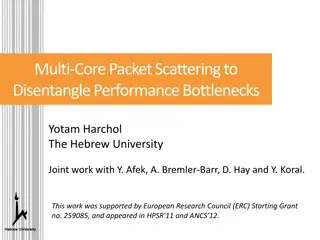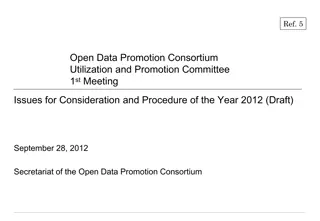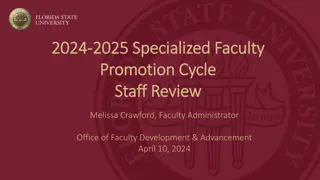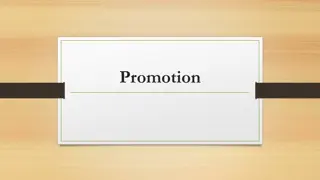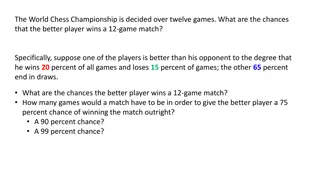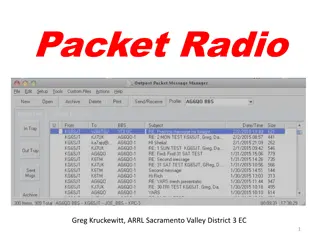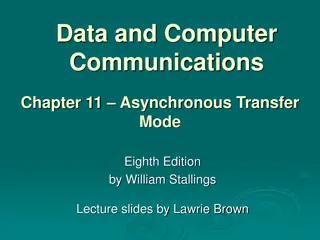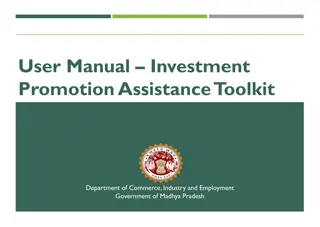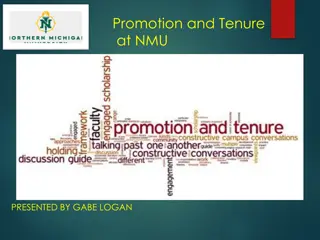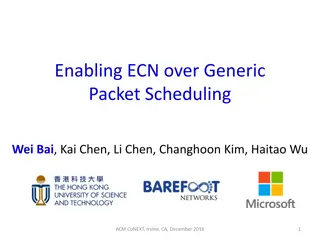Crafting a Winning Promotion Packet
The promotion process for non-tenure track faculty at Michigan State University and the essential components required in a successful promotional packet.
Download Presentation

Please find below an Image/Link to download the presentation.
The content on the website is provided AS IS for your information and personal use only. It may not be sold, licensed, or shared on other websites without obtaining consent from the author.If you encounter any issues during the download, it is possible that the publisher has removed the file from their server.
You are allowed to download the files provided on this website for personal or commercial use, subject to the condition that they are used lawfully. All files are the property of their respective owners.
The content on the website is provided AS IS for your information and personal use only. It may not be sold, licensed, or shared on other websites without obtaining consent from the author.
E N D
Presentation Transcript
Putting Together a Successful Promotional Packet Suzanne Lang Interim Associate Provost and Associate Vice President Academic Human Resources
The MSU Philosophy Promotion is a key branch point in a faculty member s life. The opportunity to be recognized for accomplishments through promotion to a higher academic rank is as important to non-tenure track faculty as it is for others. Academic rank should reflect University expectations about quality of relevant accomplishments, regardless of whether or not one is in the tenure system.
The Key: While the mix of duties performed by fixed term faculty may vary within and across units, academic rank at Michigan State University must be based on standards that result in a progressively stronger faculty. A fixed term faculty member's level of accomplishment, even if limited to a narrow range of duties (e.g. only teaching), should reflect the same level of accomplishment for that set of duties as is required for a tenure system faculty member being promoted to the same rank.
Materials to be included, using Form D: 1. Current curriculum vita, 2. Reflective essay about accomplishments over the reporting period and vison for the future (5 page maximum) 3. A representative sample of scholarly work, and 4. Evidence of excellence in performing assigned duties, e.g. significance, impact, and innovation of research/creative activities, instructional activities, and service.
Additional important points: Because of the diversity in assignments of fixed term faculty, unit administrators must prepare a description of the candidate's assignment, including, for example, the percentage of the appointment devoted to research/creative activities, teaching, service, etc. External review letters may be used, to the extent relevant, following the principles in the policy, "External Letters of Reference."
THE REVIEW PROCESS Department level committee makes recommendation to chair or school director Chair independently makes a recommendation to the dean The dean is advised by a college review committee The dean independently makes a recommendation to the provost
Rule #1 TALK TO YOUR CHAIR/DIRECTOR & MENTOR(s)
Tracking and Documenting Your Accomplishments Adapted from a presentations by: Ann E. Austin Academic Advancement Network Assistant Provost for Faculty Development Academic Career Paths & Juli Wade Academic Advancement Network Associate Provost for Faculty and Academic Staff Development
Why is documentation important? Helps make the case for who you are, what you have accomplished, why it is important, and your expected future trajectory But You can t document what you don t remember You can t document what you don t have evidence to support
Documentation demonstrates who you are as a professional: The type of work you do What the synergies/connections are across the components of your work The impact you are making Your path to date Your trajectory as you look forward Your vitality and excellence in your role
What should you document? All aspects of your work the components related to your assigned duties, and all of the extra responsibilities you take on. Typically, you will organize your documents around three key categories, to the extent appropriate: Teaching Research Service and/or Outreach The connections across the components of your work
How to document your work? Establish a system for record-keeping electronic or paper Be consistent, systematic, and organized Archive each significant event and benchmark in your professional career Seek and plan ways to demonstrate impact
Teaching Records to Keep Formal Classes Schedule, class size, format Syllabi, course material Exams and grade distribution Student evaluations and summary scores Advising and Mentoring Formal advising load Mentoring relationships Students supervised in components of your work Workshops, Seminars, etc. Format, materials, evaluations
Teaching Records to Keep Course and Curriculum Development Development and redesign of courses Teaching materials developed Out-of-class experiences designed Professional Activities Professional development opportunities Instructional research and grants
Teaching Issues for Reflection Your philosophy and approach Your intended learning outcomes for students Your teaching methods, and rationale for them Approaches and innovations you have developed Impact on students: outcomes assessment, unsolicited comments How you interpret and respond to your teaching evaluations How your teaching has changed over time and why
Research, Scholarship & Creative Activities Records to Keep Products Books/monographs Book chapters Articles in refereed journals Creative works, such as exhibits and performances Edited works: journals, other publications Presentations at scholarly/professional meetings Other papers, reports, reviews Funding Grant proposals: funded and non-funded Grant management: budget, staff Reports
Research, Scholarship & Creative Activities Records to Keep Involvement in the Discipline Manuscript reviews, conference proposal reviews Grant evaluation panels Leadership activities in professional societies Standing in the Discipline Journal rankings Citation analysis Reviews and published reactions Awards and honors Invited talks and activities Unsolicited testimonials
Research, Scholarship & Creative Activities Topics for Reflection Overall direction and purpose of your research Questions you are addressing Methodologies selected and benefits/limitations Impact: Major outcomes, why this work is important, whom it impacts Future plans and issues to be addressed
Service Records to Keep At MSU Department, college, university leadership roles Department, college, university committees Task forces and reports For Professional Organizations Leadership roles elected and appointed Committee memberships Conferences/events planned
Service Records to Keep For the Broader Community Consultation and technical assistance to organizations Publications for the public and audiences outside your field Interpretations of technical information for the public Expert testimony Development of programs in educational/cultural organizations Clinical Work Diagnosis and treatment of clients and patients Supervision of staff in clinical settings
Service and Outreach Topics for Reflection Overall direction and purpose of your service/outreach Rationale for selecting these areas of focus Impact major outcomes, who is impacted, why the work is important Future directions
Major Components of Packet Reflective Essay Form D CV Publications, Creative Works
Reflective Essay It Should: Describe how you contribute to the missions of MSU (relative to your assignment) and society more broadly; impact and broader context should be explained If research/creative activities is a part of your assignment, then highlight what you have done and where you are going Make a cohesive trajectory clear Tell a story about your vision and progress toward it Be a polished document that includes some specific examples Communicate at a level appropriate for knowledgeable people who are not in your discipline
Reflective Essay It Should Not: Simply summarize what is in CV or Form D (or be a list of what you ve accomplished) Use a lot of jargon
Reflective Essay Questions to Ask Yourself: - Why do you do what you do? And why does it matter to people other than you? - What do you want to be known for, and why?
Reflective Essays General Advice: Get information from senior colleagues and unit leaders about the culture in your department and college regarding style and content of the document. Review examples from successful promotion cases.
Form D Basic Documentation (1 of 3) Undergraduate and Graduate Instruction List of courses taught, including number of students in them Non-Credit Instruction Academic Advising (UG advising by faculty only in some units) Instructional Works (publications, presentations, etc. with teaching focus)
Form D Basic Documentation (2 of 3) Research and Creative Activities List of items produced Quantity of items across categories Number of grants (details are listed at end of document) Service Scholarly and professional organizations University Broader community
Form D Basic Documentation (3 of 3) Evidence of Other Scholarship Impact of and attention to any work that is not specifically associated with teaching, service, research or creative activities Integration across Multiple Missions Other Awards/Evidence
Form D Common Mistakes to Avoid Entering the wrong duty period on page 1 Typos, sloppy language Not answering all of the questions
